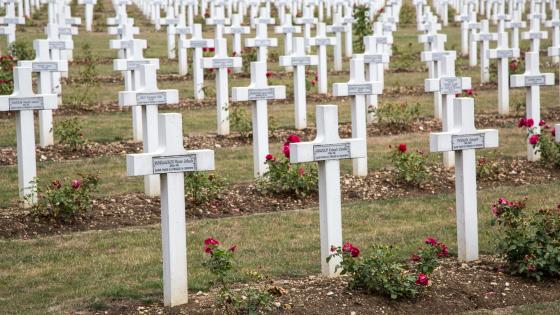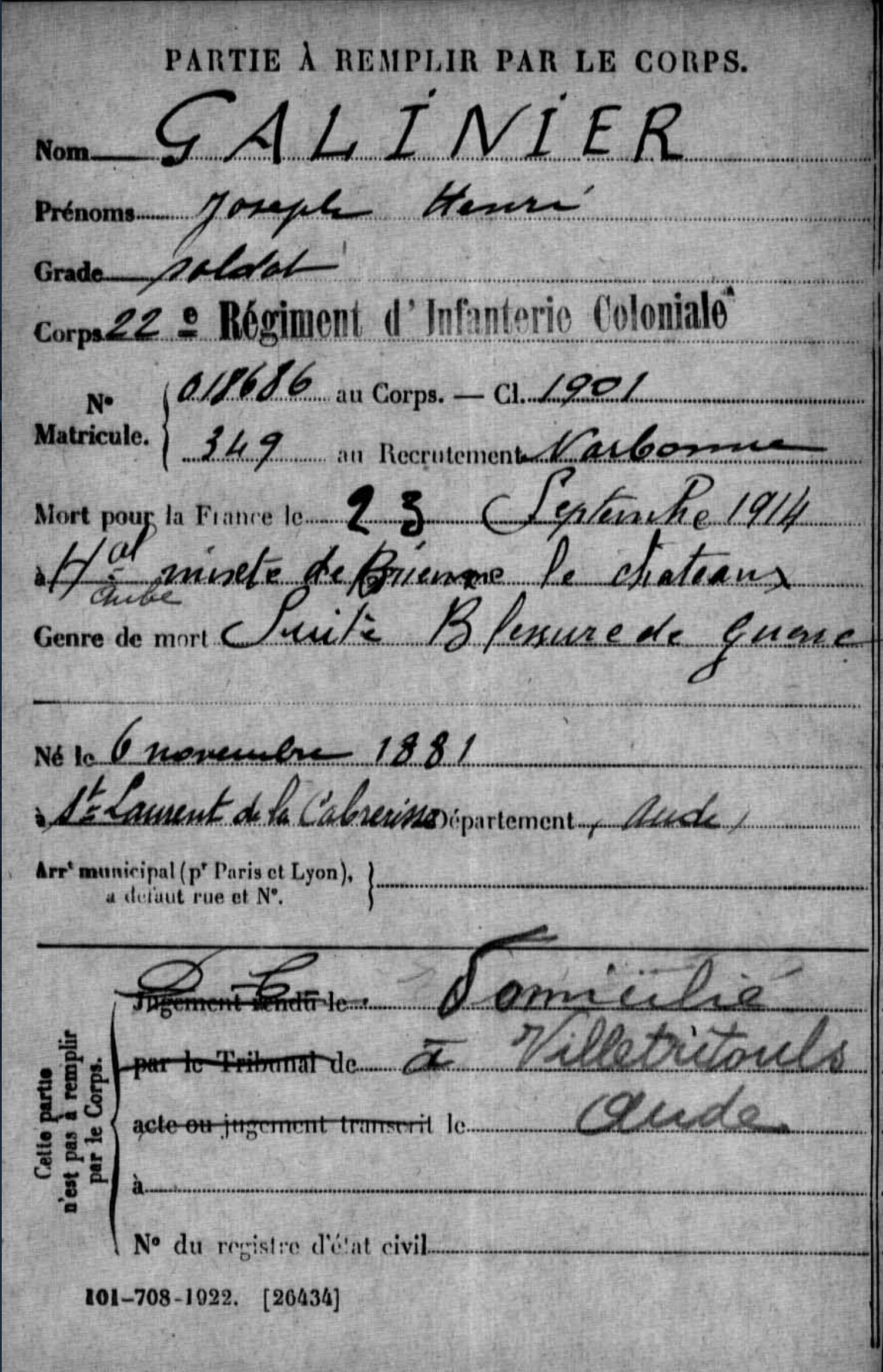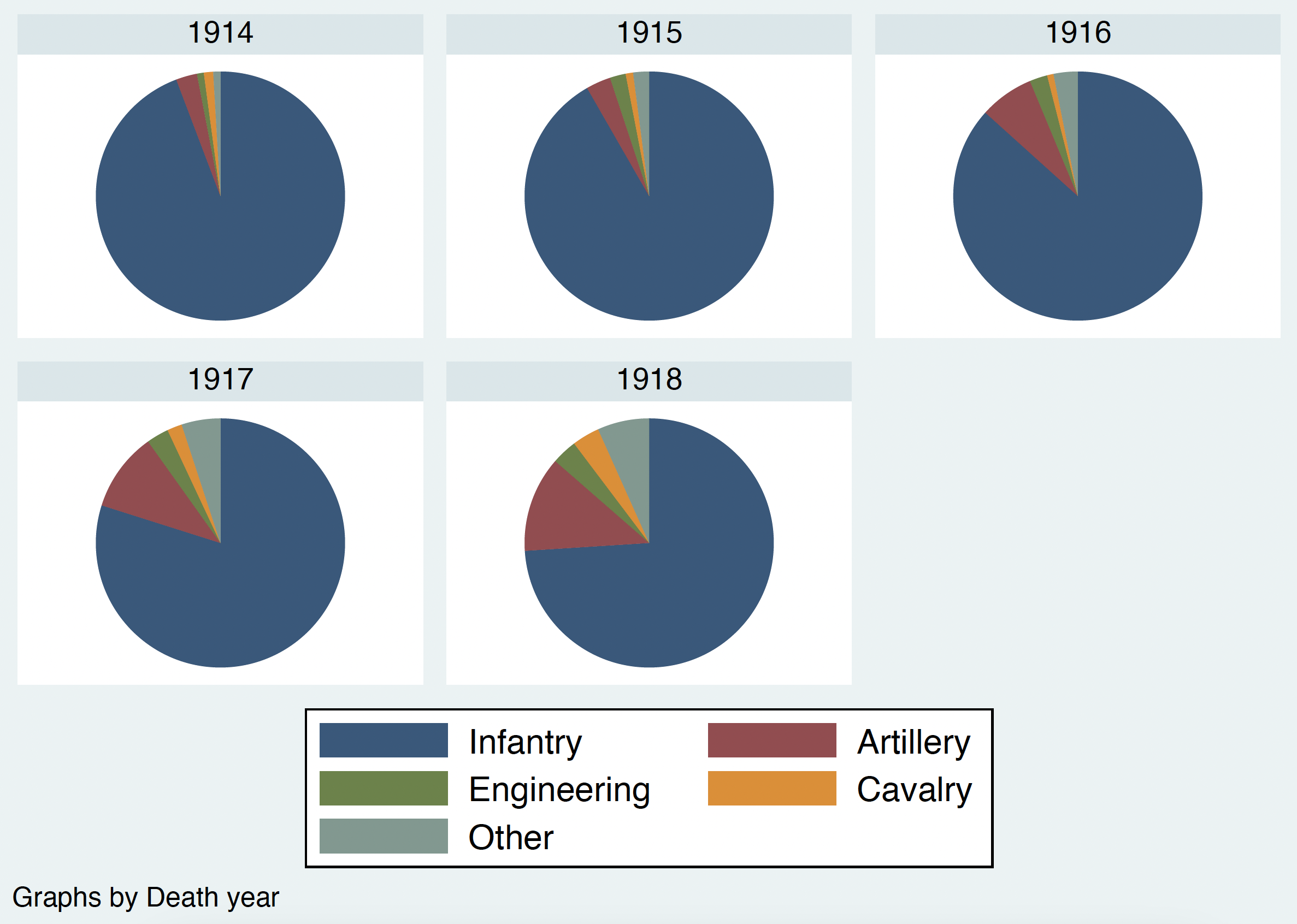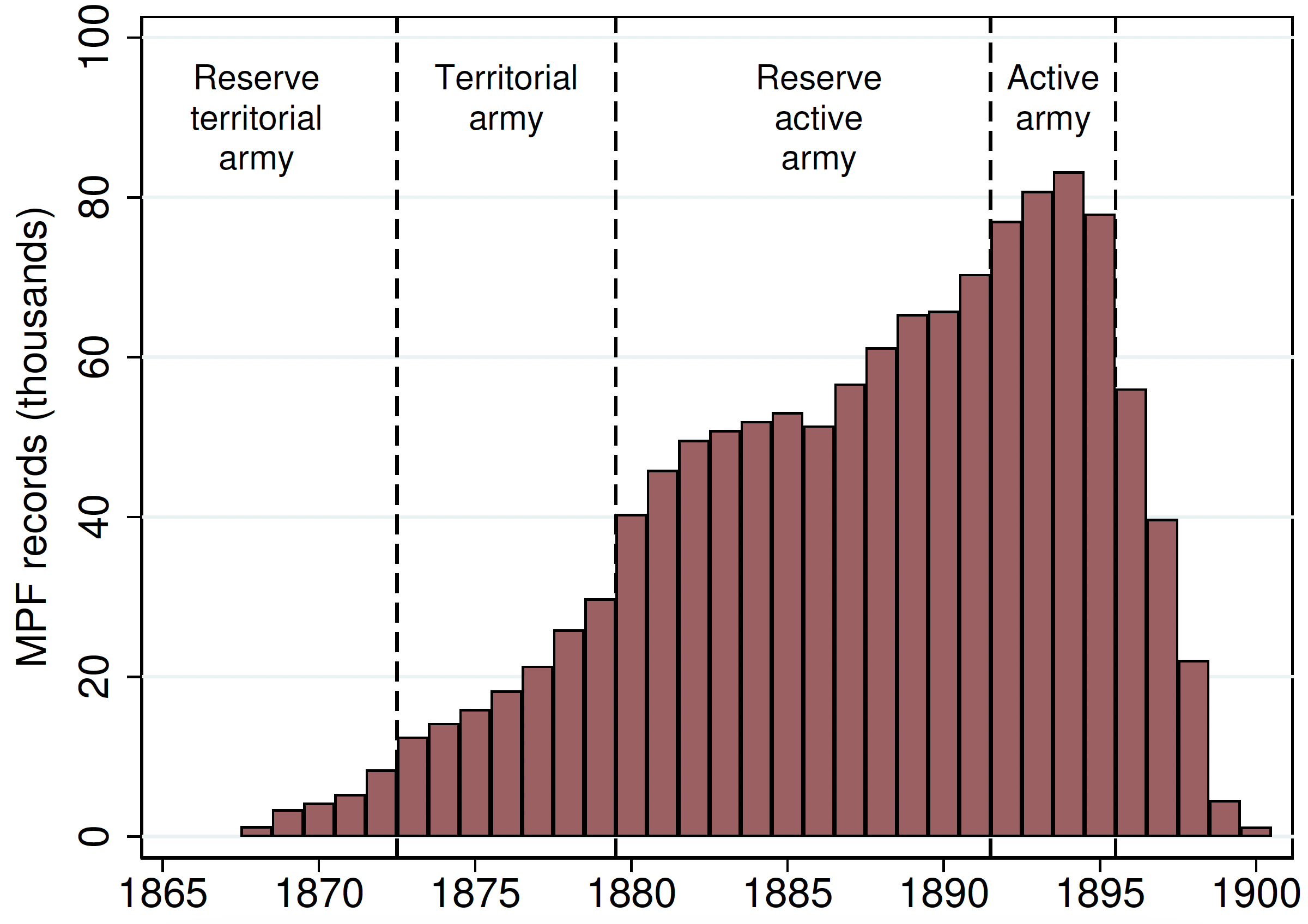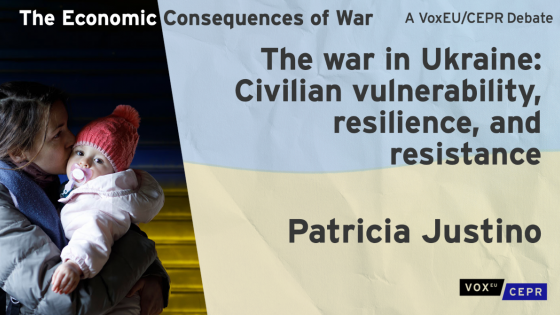Wars are also fought with statistics. As the war in Ukraine rages on, getting precise and accurate statistics on the number of those killed or injured in combat is a difficult statistical endeavour – one that even the world’s best intelligence services struggle with – as well as a politically sensitive exercise (Crawford 2022). Maintaining morale necessitates manipulating statistics, inflating an opponent’s death count and deflating one’s own. After wars are fought, manipulated or simply incorrect statistics can affect not only compensation payments and war reparations, but memory and national narratives too. Historical data can and must bring new evidence to bear on the effects of war and on the dynamics of memory. To this end, several research teams have recently assembled and released new data on WWI fatalities in Germany (De Juan et al. 2023), Italy (Fornasin 2017, Acemoglu et al. 2022), the UK (Bailey et al. 2023, Carozzi, Pinchbeck et al. 2023), and Australia (McCalman et al. 2019). We recently published a new database that contributes to this effort for one of the conflict’s major protagonists, France. This column reports on new findings revealed by the data.
World War I in France
WWI was a watershed moment for French society. Over four years of battle, more than eight million French men served in the army, and historians have estimated that 1.3–1.5 million of them died in combat, representing between 16% and 18% of the male population of conscripts (e.g. Prost 2008, Héran 2014). The imprint of the conflict on France’s demography was profound. The war depleted several cohorts of young men and cut a lasting gash in the French population pyramid (Héran 2014, Bellis et al. 2022). Fertility plummeted and its modest post-war uptick hardly replaced the million ‘missing’ children that were never born (Rohrbasser 2014). The gender imbalance resulting from the war disrupted marriage markets (Abramitzky et al. 2011) with dramatic implications for the economy writ large, as an entire generation of war widows and single women was drawn into the labour force (Boehnke and Gay 2022). This labour supply shock perpetuates today (Gay 2023). Politically, the Great War may have laid the seeds for France’s rapid defeat to Germany in 1940 (Bloch 1946), and some its features help explain the collaboration with Nazi Germany on Philippe Pétain’s accession to power (Cagé et al. 2023).
A unique historical effort to commemorate war deaths: The Morts Pour la France database
The French army was already facing unprecedented mass mortality in the first few months of the war (Prost 2008, Bach 2010). To foster patriotism and mitigate the risk of demoralisation, the government implemented a set of measures to pay tribute to those who had died in its name (Petit 2016). The official honorary title attributed to soldiers and French civilians who died as a result of military operations – Mort pour la France (“Dead for France”) – materialised in December 1914, eventually passing into law in July 1915. We discuss the inclusion criteria and consequent limitations of the data source in more detail in Gay and Grosjean (2023).
The nation’s homage to war victims was structured by the law of 25 October 1919, which stipulated the writing of a Livre d’Or (Golden Book) containing the names of all individuals who had received the Mort pour la France recognition (Chabord 1973, Richard 2013). Due to budgetary restrictions, the Livre d’Or never saw the light of day, but its source material – 1.5 million individual cards – was digitised by ‘citizen historians’ under the initiative “1 Jour–1 Poilu” (Gilot et al. 2018). The MPF record of one of the authors’ ascendants is displayed in Figure 1.
The resulting Morts pour la France (MPF) database includes a host of individual-level information: first and last names, dates of birth and death, recruitment status, military rank and unit, and places of birth and recruitment. Our contribution is to clean the raw data and – after removing duplicates and soldiers born outside France – create a curated database of 1,270,86 individuals with standardised fields and interoperable nomenclatures compatible with historical and current geographic information systems (Gay 2021, IGN 2015).
Figure 1 Record of a Mort pour la France
Notes: Example of an MPF card, belonging to Joseph Henri Galinier, 22d Colonial Infantry Regiment, Mort pour la France on 23 September 1914, in Brienne-le-Château from war injuries. He was born on 6 November 1881, in Saint-Laurent-de-la-Cabrerisse, in the département of Aude.
New historical facts and avenues for research
Municipal geography of deaths
The unprecedented granularity of the MPF database opens several avenues for research into the characteristics and consequences of the conflict. In particular, we provide municipal-level military death rates, which dramatically improves on the sources of geographic variation that can be used to identify the consequences of the war. Previously, researchers relied almost exclusively on subsamples of the underlying MPF data at the level of 87 départements, or 21 military regions. The municipal geography of fatalities displayed in Figure 2 shows how the more rural, poorer, and less industrialised areas of France were harder hit.
Figure 2 Military death rates across municipalities
Notes: This figure displays the distribution of military death rates across municipalities within the boundaries of France as of 1914. It is the ratio of non-civilian male MPFs who died between 1914 and 1919 to the total population in 1911. The data are mapped in 2015 geography using the shapefile of IGN (2015).
Most deadly battle
The MPF database also improves our understanding of battle-specific violence. For instance, we discover that the deadliest day in French history was 25 September 1915, the first day of the Second Battle of Champagne, on which 22,157 French soldiers died. Previous historiography suggested that the deadliest days of the conflict occurred in the early weeks of the war during the Battle of the Frontiers and the First Battle of the Marne (Steg 2013). Incidentally, the First Battle of the Marne – known by most French simply as the “Battle of the Marne” and immortalised by the imposing Dormans Memorial – was a great military victory for the French Army, which pushed back the German advance and saved Paris. The Second Battle of Champagne, by contrast, was a French offensive that ended in French retreat and, as shown in Figure 3, had the highest number of fatalities in a single day among French metropolitan troops.
Figure 3 Daily number of military fatalities
Notes: This figure displays the number of daily fatalities in the MPF database between 2 August 1914 and 11 November 1918 among non-civilian MPFs born in France and for which the date of death is available (1,212,936 MPFs in total). Notably deadly dates are highlighted with accompanying events on the front. Other dates are provided for reference.
Deaths by unit
The database also reveals how conflict technology evolved. While the overwhelming majority of MPFs were part of the infantry (1.1 million records, or 86% of MPF records), the share of the infantry decreased over the course of the war (from 94% in 1914 to 74% in 1918), while the share of the artillery increased (from 3% in 1914 to 13% in 1918).
Figure 4 Shares of fatalities in different corps over the course of the conflict
Notes: Share of deaths among each main Army corps as a percentage of total deaths in every year of the conflict.
Dates of birth
While conscription directly concerned the cohorts 1866–1900 (i.e. men between the ages of 19 and 48 in 1914, and all those who turned 19 prior to the end of demobilisation in November 1919), birth dates range from 1824 to 1917, though only 3,571 MPFs were born between 1824 and 1865 or between 1901 and 1917 (0.28% of MPF records). We display the distribution of birth years among MPFs born between 1866 and 1900 in Figure 5. The median MPF was born on 22 February 1889. Figure 5 shows that the most affected cohorts were those in the active army (1891–5), the younger men ranging from 19 to 23 in 1914 who were sent first to the front lines, namely as part of the line infantry regiments.
Figure 5 Distribution of years of birth among MPF records
Notes: Each bar represents the number of individuals with MPF records born in a given year. The figure is restricted to the cohorts 1866–1900, which represent 1,267,771 MPF records. It further indicates the armies to which MPF cohorts belonged in 1914 (post-1895 cohorts were drafted after 1914).
In sum, our paper (Gay and Grosjean 2023) contributes to a recent data collection and publication effort of detailed individual databases of military fatalities, which reveal new facts and opens new avenues of research into the demographic, socio-economic, and political consequences of WWI in Europe.
References
Abramitzky, R, A Delavande and L Vasconcelos (2011), “Marrying Up: The Role of Sex Ratio in Assortative Matching”, American Economic Journal: Applied Economics 3(3): 124–57.
Acemoglu, D, G De Feo, G De Luca and G Russo (2022), “War, Socialism, and the Rise of Fascism: an Empirical Exploration”, The Quarterly Journal of Economics 137(2): 1233–96
Bach, A (2010), “La Mort en 1914–1918”, Revue Historique des Armées 259: 23–32.
Bailey, R E, T J Hatton and K Inwood (2016), “Health, Height and the Household at the Turn of the 20th Century”, Economic History Review 69(1): 35–53.
Bellis, G, J-F Léger and A Parant (2022), “The Great War (1914–1918): A Demographic Catastrophe. Immediate and Long-Term Consequences of the First World War on the French population”, Space, Populations, Societies, 2–3.
Bloch, M (1946), L’Étrange Défaite, Société des Éditions Franc-Tireur.
Boehnke, J and V Gay (2022), “The Missing Men. World War I and Female Labor Force Participation”, Journal of Human Resources 57(4): 1209–41.
Cagé, J, A Dagorret, P A Grosjean and S Jha (2023), “Heroes and Villains: The Effects of Heroism on Autocratic Values and Nazi Collaboration in France”, American Economic Review, forthcoming.
Carozzi, F, E Pinchbeck and L Repetto (2023), “Scars of War: The Legacy of WWI Deaths on Civic Capital and Combat Motivation”, CESifo Working Paper 10298.
Chabord, M-T (1973), “Le Livre d’Or de la Première Guerre Mondiale: Un Projet Sans Suite”, Revue Historique de l’Armée 2: 76–89.
Crawford, N (2022), “Reliable death tolls from the Ukraine war are hard to come by”, The Conversation, 4 April.
De Juan, A, F Haass, C Koos, S Riaz and T Tichelbaecker (2023), “War and Nationalism: How WW1 Battle Deaths Fueled Civilians’ Support for the Nazi Party”, American Political Science Review, 1–19.
Fornasin, A (2017), “The Italian Army’s Losses in the First World War”, Population 72(1): 39–62.
Gay, V (2021), “Mapping the Third Republic. A Geographic Information System of France (1870–1940)”, Historical Methods: A Journal of Quantitative and Interdisciplinary History 54(4): 189–207.
Gay, V (2023), “The Intergenerational Transmission of World War I on Female Labor”, The Economic Journal 133(654): 2303–33.
Gay, V and P Grosjean (2023), “Morts pour la France: A Database of French Fatalities of the Great War”, CEPR Discussion Paper 18211.
Gilot, J-M, M Grandjean and F Clavert (2018), “1914–1918: Quand la Commémoration devient Participative”, Le Temps des Médias 31(2): 219–29.
Héran, F (2014), “Lost Generations: The Demographic Impact of the Great War”, Population Societies 510(4): 1–4.
IGN (2015), Geofla, Communes édition 2015, France Métropolitaine [database], Paris: IGN.
McCalman, J, R Kippen, J McMeeken, J Hopper and M Reade (2019), “Early Results From the ‘Diggers to Veterans’ Longitudinal Study of Australian Men who Served in the First World War. Short- and Long-Term Mortality of Early Enlisters”, Historical Life Course Studies 8: 52–72.
Petit, V (2016), “‘Mort pour la France’ ou le Triomphe d’une Théologie Nationale (1914–1915)”, Histoire, Monde & Cultures Religieuses 37: 175–79.
Prost, A (2008), “Compter les Vivants et les Morts: L’Évaluation des Pertes Françaises de 1914–1918”, Le Mouvement Social 2008/1(222): 41–60.
Richard, D (2022), “Les livres d’or des Morts pour la France de la Première Guerre mondiale”, Archives Nationales (France).
Rohrbasser, J-M (2014), Bouleversements Démographiques de la Grande Guerre, Paris: INED.
Steg, J-M (2013), Le Jour le Plus Meurtrier de l’Histoire de France: 22 Août 1914, Paris: Fayard.
